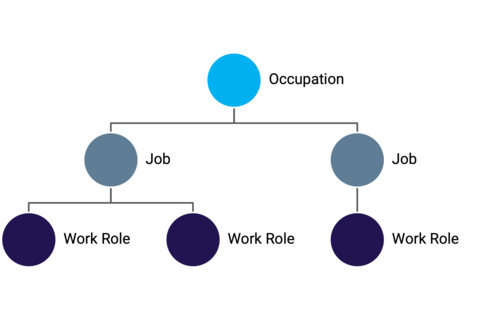Occupations, Jobs, and Work Roles
The NICE Workforce Framework for Cybersecurity (NICE Framework) (NIST SP 800-181r1) establishes a common language to describe cybersecurity work and the knowledge and skills needed to do that work. It does this via Task, Knowledge, and Skill statements that define Work Roles and Competency Areas.
The distinction between Competency Areas and Work Roles is one that is discussed in more detail in NIST Interagency/Internal Report 8355: NICE Framework Competency Areas: Preparing a Job-Ready Cybersecurity Workforce. However, it is essential to understand how Work Roles, Jobs, and Occupations differ – and how they relate – to each other.
There is often confusion around these similar terms, so much so that sometimes you will hear them used interchangeably. The NICE Framework defines a Work Role as “A grouping of work for which an individual or team is responsible or accountable.” But Work Roles are not synonymous with jobs or occupations. Those can be described as:
- Occupation: A category of jobs that are similar with respect to the work performed and the skills possessed by workers.[1] Each of the jobs in an occupation can include one or more Work Roles.
- Job: A job is a specific instance of employment[2] – in other words, a set of responsibilities based on work roles within an occupation as defined by an employer.[3] A single job may be responsible for one or more Work Role or for only a portion of a role. Additionally, a team may be responsible for a one or more Work Roles. Depending on the organization, a job title may coincide with a Work Role, or the Work Role may pertain to many varying job titles. For instance, the Work Role “Secure Software Development” may apply to software engineers, coders, and application developers.
- Work Role: As stated above, a Work Role is a grouping of work for which an individual or team is responsible. Work Roles include a role name, definition, and associated grouping of related Task statements that specify the work to be done. Task statements in turn are associated with Knowledge and Skill statements that describe what someone must know or be able to do in order to complete the task. The NICE Framework currently comprises 52 Work Roles in seven categories (learn more here).
The below figure shows how occupations, jobs, and work roles relate to each other.

NICE Framework Work Roles are used discover and plan for careers; develop and align learning courses and programs; create job descriptions and conduct performance-based assessments; track workforce capabilities; and more. Learn how you can use NICE Framework Work Roles and engage with others at the NICE Framework Users Group.
[1] U.S. Bureau of Labor Statistics, “Glossary” (Retrieved 2024). Available at: https://www.bls.gov/bls/glossary.htm#O
[2] U.S. Bureau of Labor Statistics, “Glossary” (Retrieved 2024). Available at: https://www.bls.gov/bls/glossary.htm#J
[3] Credential Engine Technical Site, “Credential Transparency Description Language” (Retrieved 2024). Available at: https://credreg.net/ctdl/terms/Job

